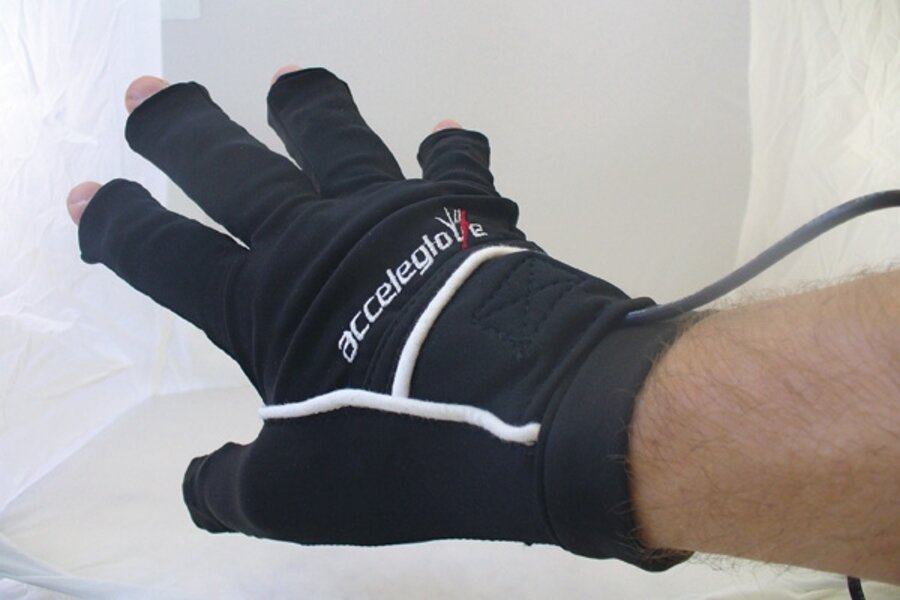AcceleGlove: The future of motion at your fingertips
Loading...
A group of American soldiers is on patrol in hostile territory. Suddenly, the squad leader realizes they’ve stumbled onto the edge of what may be a minefield and quickly gives a hand signal to halt. His troops don’t have to be watching him or even be able to see him to get his signal: They feel it as a vibration in a special belt or vest they’re wearing. Using a different set of hand signals, the leader then directs an unmanned robotic vehicle to investigate the possible mines, keeping his fighters out of harm’s way.
This futuristic scenario may not be far off. The battlefield is fast becoming a high-tech arena. But as soldiers use technology to gain a better understanding of their surroundings, they also risk being overloaded with information.
That’s where “haptics,” or tactile feedback technology, comes in. Fighters’ eyes and ears are being bombarded by data, not only the sights and sounds of the battlefield but information from audio and video sources. Rather than overwhelming the eyes and ears, haptics taps into a different sense. For example, it can collect data through motion controls or relay information through vibration.
Consumer products such as Apple’s iPhone and Nintendo’s Wii game controller have already adopted haptics, using sensors called accelerometers to pick up on spins, shakes, and button presses, then they respond with a buzz or vibration.
A new product called the AcceleGlove, which went on sale in May, capitalizes on the shrinking cost of accelerometers and rapid processing power. The glove is studded with accelerometers, which can track the movement of a hand and individual fingers. Altogether, they allow the wearer to control other devices, from robots to video games.
AnthroTronix Inc. of Silver Spring, Md., a research and development company, hopes to adapt its AcceleGlove for law enforcement, firefighting, controlling robots in space or in dangerous industrial settings, rehabilitation, hand-motion studies, telemedicine, and as a computer interface with video games and virtual reality.
At $499, “you’re talking [about a price] that any grad student” could afford to conduct research, says Cori Lathan, founder and CEO of AnthroTronix.
The glove could be a teaching tool for anything from learning American Sign Language to practicing a sensitive surgical procedure. Baseball players might use the glove to study their grip and throwing motion.
“Our hope is that the [video] gaming community will develop applications,” Ms. Lathan says. If the gloves are produced in large quantities, she anticipates the price could drop to about $200 each.
Right now, AnthroTronix is “probably right in the middle of the valley of death” for being adopted by the military – beyond the research phase but waiting for an actual order, Lathan says. The company currently receives research funding from the US Army, Navy, and Air Force and has received money from the Department of Defense’s research-and-development agency.
For modern soldiers, “managing all the information that’s out there is almost overwhelming when you’re supposed to be focused on your own safety on patrol,” says Gerry Mayer, director of the Artificial Intelligence Laboratory at Lockheed Martin Advanced Technology Laboratories in Cherry Hill, N.J. “And with robots, you have to have a dedicated amount of time and energy to maneuver the robot, and you’re taking away from your own safety. So if you don’t have capabilities such as these that AnthroTronix is working on, we’re going to cause the soldiers on patrol to take time away from the serious business that they’re in and spend time managing either information or robots.”
Sensors in the gloves could “passively” pass along other vital information, says Jack Vice, president and cofounder of AnthroTronix. For example, they could keep track of how much ammunition soldiers have fired and alert a platoon commander that his troops are running low.
Assuming the AcceleGlove catches on, the company wants to develop a new version that will include more accelerometers to capture motion with even higher fidelity and a digital compass that could reveal which direction it is pointed. A robot could be instructed, “Hey, go that direction 300 meters,” using signals from the glove alone, says Mr. Vice, who served as part of a Marine infantry special operations unit for six years.
While other companies are working on glove-based controllers, AnthroTronix “seems to be about the furthest along in having a practical, useful system,” says Mr. Mayer, who has teamed up with AnthroTronix on a number of projects.
A potential investor is impressed. “I think it’s the future.... Look at how we’re flying those armed drones: You have people in the United States who are flying planes in Iraq. It’s pretty amazing,” says Andrew Sachs, the founder and managing director of Sachs Capital, a private equity fund in Bethesda, Md., who has followed AnthroTronix for several years and is considering investing.
“The applications are endless when you think about interacting with things,” he says. “We’re just starting to figure this stuff out and what the possibilities are.”
In the years ahead, Lathan says, such gloves could become a kind of “virtual mouse” controlling much of the way we interact with computers and machines, much in the way the futuristic movie “Minority Report” depicted.
But the keyboard and mouse might still be used for a long time to come, especially to enter text. “The QWERTY keyboard was designed [in the 19th century] to be completely inefficient so that you didn’t jam typewriter [keys],” Lathan says. And yet we can’t get rid of it. “We’ll still have a keyboard. We’ll still have a mouse. Maybe it will all be virtual.”





